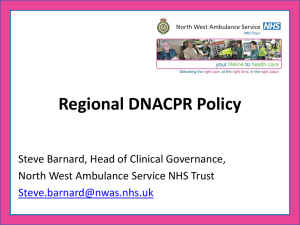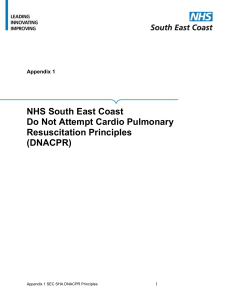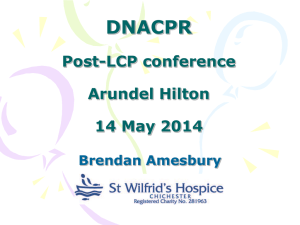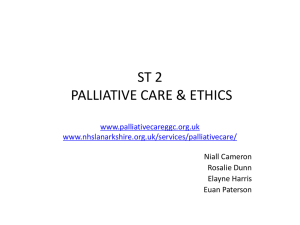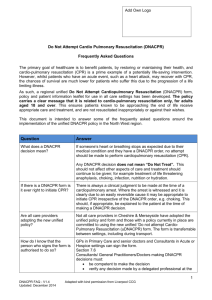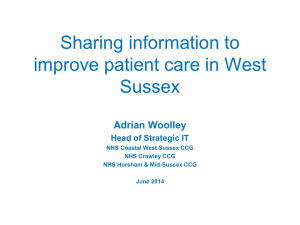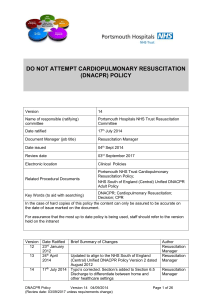DNACPR Quick Reference Guide
advertisement
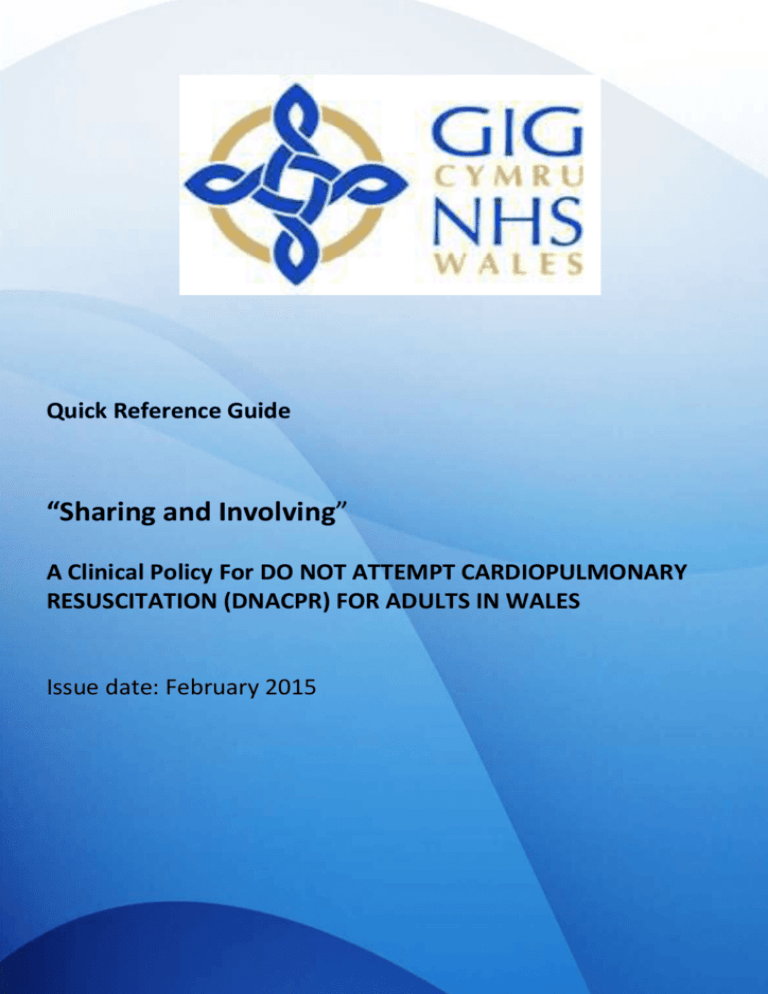
Quick Reference Guide “Sharing and Involving” A Clinical Policy For DO NOT ATTEMPT CARDIOPULMONARY RESUSCITATION (DNACPR) FOR ADULTS IN WALES Issue date: February 2015 Introduction to DNACPR This document is a summary of the key elements contained within the policy. A patient information leaflet is provided for patients and those close to them to explain the reasons for the policy. One aim of this DNACPR policy is to help raise awareness of the importance of discussions that relate to wishes at the end of life. It will help us develop the correct, personal approach, with respect to DNACPR. The purpose of this policy is to provide a unified framework for professionals in Wales - helping to ensure a uniform approach to decisions relating to the provision of CPR at the end of life. DNACPR discussions can be difficult and should be conducted in a calm, professional and reflective manner. DNACPR decisions should always involve senior professionals. DNACPR decisions should be recorded on an All Wales form that will be recognised across health sectors in Wales Throughout the policy “DNACPR” refers solely to the provision of Cardio-Pulmonary Resuscitation and not to any other aspect of the individual’s care or treatment options. CPR – Cardiopulmonary Resuscitation CPR is a technique used to maintain the body’s circulation and breathing. It usually means “pressing the chest” and providing ventilation to the lungs. In some cases “defibrillation” using electric shocks and also intravenous injections of medication may be used. DNACPR This refers to a specific decision NOT to provide CPR in the event of a cardiac arrest. It must be made clear to all that a DNACPR decision does NOT impact on any other element of care. Having the discussion and reaching a decision For professionals - recognising when to “consider DNACPR” may not always be straightforward. Quite often “envisaging the possibility of a cardiac arrest or death” in light of the current illness forms its basis. Knowing the wishes of the patient is very important and making DNACPR decisions before a patient becomes too unwell is good practice. This requires members of the medical and nursing team to establish a bond of trust reaching a shared position with the patient and involving those closest to them. If CPR will not restart the patient’s heart or maintain breathing If the clinical team is as clinically certain as it can be that attempting CPR would not re-establish effective circulation (and maintain breathing) then CPR need not be attempted. To provide CPR in such circumstances would justifiably not be in the patient’s interest. This is always an individual clinical decision that must be based on up-to-date knowledge of the patient’s condition. It is expected that in most situations that this will be discussed with the patient and with those closest to them. If the potential “harmful effects” of CPR is greater than potential benefits Any potential of benefit from CPR must be balanced against “risk of harm”. The patient’s recently expressed wishes are hence very important. If for example, a patient is in the final stages of an incurable illness and death is expected within a few days, CPR is unlikely to be successful and could prolong suffering. Best interest decisions in general are most easily reached in those circumstances where there is a clinical consensus that benefit is very low or risk of harm from CPR likely to be very high (See joint statement). In some circumstances, a natural death free from the “invasive” intervention of CPR may be considered. It might be possible to reach a clinical position of a Natural Anticipated and Accepted Death (NAAD) with the patient (please see policy). Deciding that a case warrants a DNACPR decision The All-Wales DNACPR decision-making framework schematic is illustrated below. This includes clinical events that might act as a “trigger” for a team-based DNACPR discussion. It also outlines key questions clinicians that should ask themselves in order to decide if a DNACPR discussion is warranted. SCHEMATIC FRAMEWORK FOR DNACPR DECISION-MAKING Question 1 IS THE CLINICAL CASE A TRIGGER FOR A CPR DISCUSSION ? (A CLEARLY POSSIBLE CARDIAC ARREST)? YES Question 2 IS ATTEMPTING CPR LIKELY TO BE CLINICALLY BENEFICIAL? NO NAAD or DNACPR RECORD THIS DECISION* YES Question 3 DOES THE PATIENT HAVE REQUISITE MENTAL CAPACITY OR IS THERE AN LASTING POWER OF ATTORNEY FOR HEALTH & WELFARE FOR THIS DECISION? NO Refer to policy section 5.4 YES YES Question 4 CAN AN INFORMED DISCUSSION TAKE PLACE? IS THERE AN ADVANCE DECISION TO REFUSE TREATMENT? YES NAAD or DNACPR RECORD THIS DECISION* NO CPR Note for clinicians - For details related to each box you MUST consult the accompanying complete All Wales DNACPR Policy No* - Refer to section 5.4 of All Wales DNACPR Policy relating to MCA NO* Documenting & Communicating the DNACPR Decision Documentation of DNACPR decisions The All Wales DNACPR form is the agreed form for recording DNACPR decisions in Wales. All relevant sections of the form must contain entries. It relates only to DNACPR decisions and the original copy forms part of the medical record. A DNACPR form is ONLY active when dated, timed, and signed with the GMC No. entered by a medical professional. Do Not Attempt Cardio Pulmonary Resuscitation (DNACPR) forms must be correctly completed and contain up to date information. The form must be completed in legible handwriting and also signed and dated. Further details on copies and communication can be found within the All Wales policy. Senior clinical responsibility for every DNACPR decision A senior clinician is responsible for overseeing DNACPR decisions. Agreed DNACPR decisions must be relayed to the senior responsible clinician (usually the senior responsible clinician will be the patient’s GP in the community setting or a consultant). They must be informed if an All Wales DNACPR form has been completed. If this clinician is not physically present at the time of the discussion and decision then it must be clearly recorded on the form after they have been informed. Communication of a DNACPR decision Correct communication of a DNACPR decision is vital and should follow guidance within the All Wales policy. Further key issues relating to the Decision When DNACPR status is unknown: Unless a valid DNACPR decision is in operation with either an All Wales DNACPR form completed or a valid Specific Advance Decision to Refuse Treatment (ADRT) exists - all patients must be presumed to be “For CPR”. When a valid Advance Decision Refusing CPR exists If a valid Advance Decision to Refuse Treatment is in place (specifically relating to CPR) that was made when the patient had mental capacity and when the circumstance has arisen as envisaged (Mental Capacity Act 2005) then CPR should NOT be attempted. Refusal of CPR by patients with capacity Any person with capacity can personally refuse CPR. If a patient with capacity refuses CPR (even when it may be of benefit). This wish (and the discussions related to this) must be carefully and clearly recorded at the front of the patient’s record. Review of a DNACPR decision Should a “DNACPR review” be necessary in accordance with the policy a further DNACPR form needs to be completed only if the circumstances have clearly changed. A DNACPR review should always take place if requested by the patient. A review of the DNACPR decision might, for example, be considered: When a patient’s overall clinical condition significantly and sustainably improves warranting further discussion. On the request of patient or individual(s) the patient has chosen to be present for the decision making process. If a new discussion is warranted on clinical grounds the decision is subject to the same information sharing as the initial decision. If DNACPR is decided again then a new copy of the DNACPR form again must be handed to the patient or their advocate and communicated as per the All Wales policy. Cancellation of a DNACPR Decision In some circumstances it may be right to cancel a DNACPR decision. The original form should be clearly diagonally marked with 2 lines in black ink with “CANCELLED” written between the lines. All parties who received copies the original decision (see reverse of All Wales DNACPR form) must be contacted and informed that the DNACPR has been cancelled. The communication must be in writing and logged and contain a copy of the overwritten cancelled original document. The patient’s original copy should be returned and destroyed - in order to avoid future error. Clinical Note A DNACPR decision relates specifically to wishes expressed in the event of a predictable cardiopulmonary arrest – applying only to CPR and it does not apply to any other aspects of treatment. In clinical practice unpredictable situations can occur in patients whilst a current DNACPR is in place (please see All Wales policy). In such instances the underlying cause requires maximal treatment and temporary CPR might become necessary whilst any reversible cause is correctly managed. For More Information Please refer to “Sharing and Involving” a clinical policy for “Do Not Attempt Cardio-Pulmonary Resuscitation (DNACPR) for Adults in Wales” and the Patient Information Leaflet – accompanying this document.
